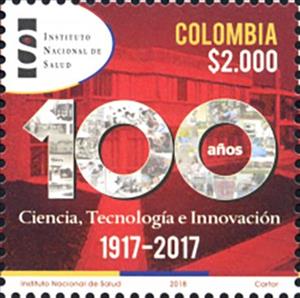Stamp: Centenary of the National Institue of Health (Colombia 2018)
Centenary of the National Institue of Health (Colombia 2018)
20 March (Colombia ) within release National Institute of Health, Cent. goes into circulation Stamp Centenary of the National Institue of Health face value 2,000 Colombian peso
| Stamp Centenary of the National Institue of Health in catalogues | |
|---|---|
| WADP Numbering System - WNS: | WAD: CO036.18 |
Stamp is square format.
Printed by Cartor Security Printing. Designed by National Institute of Health. On the upper left part of the stamp, the logo of the institute. In the central part, on a red and black background, the nuber "100" in commemoration of the centenary.Below, the inscription "science, technology and innovation" and the dates 1917-2017.Also in the issue National Institute of Health, Cent.:
- Mini Sheet - Centenary of the National Institue of Health face value 12*2000;
- Stamp - Centenary of the National Institue of Health face value 2,000;
Stamp Centenary of the National Institue of Health it reflects the thematic directions:
An anniversary is the date on which an event took place or an institution was founded in a previous year, and may also refer to the commemoration or celebration of that event. For example, the first event is the initial occurrence or, if planned, the inaugural of the event. One year later would be the first anniversary of that event. The word was first used for Catholic feasts to commemorate saints. Most countries celebrate national anniversaries, typically called national days. These could be the date of independence of the nation or the adoption of a new constitution or form of government. The important dates in a sitting monarch's reign may also be commemorated, an event often referred to as a "Jubilee".
A building or edifice is a structure with a roof and walls standing more or less permanently in one place, such as a house or factory. Buildings come in a variety of sizes, shapes and functions, and have been adapted throughout history for a wide number of factors, from building materials available, to weather conditions, to land prices, ground conditions, specific uses and aesthetic reasons. Buildings serve several needs of society – primarily as shelter from weather, security, living space, privacy, to store belongings, and to comfortably live and work. A building as a shelter represents a physical division of the human habitat (a place of comfort and safety) and the outside (a place that at times may be harsh and harmful).
Logos is a term used in Western philosophy, psychology and rhetoric, as well as religion (notably Christianity); among its connotations is that of a rational form of discourse that relies on inductive and deductive reasoning.
Medicine is the science and practice of caring for patients, managing the diagnosis, prognosis, prevention, treatment, palliation of their injury or disease, and promoting their health. Medicine encompasses a variety of health care practices evolved to maintain and restore health by the prevention and treatment of illness. Contemporary medicine applies biomedical sciences, biomedical research, genetics, and medical technology to diagnose, treat, and prevent injury and disease, typically through pharmaceuticals or surgery, but also through therapies as diverse as psychotherapy, external splints and traction, medical devices, biologics, and ionizing radiation, amongst others.




